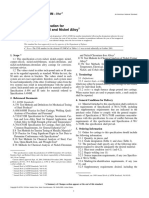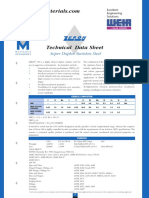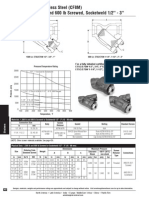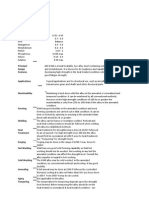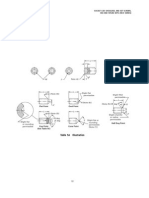Astm A890 Vs A995
Astm A890 Vs A995
Uploaded by
ok barveCopyright:
Available Formats
Astm A890 Vs A995
Astm A890 Vs A995
Uploaded by
ok barveOriginal Description:
Original Title
Copyright
Available Formats
Share this document
Did you find this document useful?
Is this content inappropriate?
Copyright:
Available Formats
Astm A890 Vs A995
Astm A890 Vs A995
Uploaded by
ok barveCopyright:
Available Formats
6/25/2019
Headlines: ined in June ... (/industry-headlines/industry-headline
Phillips 66 Planning Texas ASTM A890
SEARCH LOGIN
(/)
(http://g.adspeed.net/ad.php?do=clk&zid=48139&oid=13194&wd=600&ht=100&pair=as)
You are here: Home (/) Magazine (/magazine.html) Sections Materials Q&A (/magazine/sections/materials-q-a.html) ASTM A890
MATERIALS Q&A
ASTM A890 (/magazine/sections/materials-q-a/4278-astm-a890.html)
Q: Our piping specification requires that duplex stainless-steel castings be supplied per ASTM A890. A valve company took exception, and indicated that
duplex valve bodies and bonnets would be supplied per ASTM A995. What is the difference between these specifications?
A: ASTM A890 "Castings, Iron-Chromium-Nickel-Molybdenum Corrosion Resistant, Duplex (Austenite-Ferrite) for General Application" was released in 1988, the first ASTM
standard that covered the modern duplex stainless-steel casting grades. As such, many piping specifications include references to ASTM A890 and its various duplex grades for piping
components such as valves. Unfortunately, ASTM A890 has some shortcomings when used to purchase pressure-retaining components.
ASTM A890 references ASTM A781 "Castings, Steel and Alloy, Common Requirements, for General Industrial Use" for coverage of general requirements. ASTM A781 refers back to the
individual product specification (A890) for tensile test requirements. ASTM A890 lists tensile property requirements, but does not require that the tensile tests actually be performed. Tensile
tests are only required if Supplementary Requirement S32 is specified on the purchase order. In order to obtain a test report showing the actual chemistry and tensile test results,
Supplementary Requirement S12 must also be imposed. Marking of heat numbers on castings is not required unless specified separately on the purchase order.
In 1998, ASTM released ASTM A995 "Standard Specification for Castings, Austenitic-Ferritic (Duplex) Stainless Steel, for Pressure-Containing Parts." At first glance, this specification
appears very similar to A890. Any casting that meets A995 also meets A890. However, A995 imposes some additional requirements:
A995 includes fewer grades (1B, 2A, 3A, 4A, 5A, and 6A) than A890 (1A, 1B, 1C, 2A, 3A, 4A, 5A, and 6A), and the composition limits for the common alloys are listed with higher
precision in many cases.
A995 requires that weld repairs be made using procedures and welders qualified per ASTM A488. A890 does not.
A995 provides a definition for major weld repairs and requires post-weld heat treatment (i.e., re-solution heat treatment) after all major weld repairs. A890 only requires post-weld heat
treatment if Supplementary Requirement S33 is imposed on the purchase order.
A995 references ASTM A703 "Steel Castings, General Requirements, for Pressure-Containing Parts," instead of A781. A703 imposes several other requirements that are not included
in A890 nor A781:
Each heat of material must be tensile tested.
Each casting must be hydrostatically tested.
Each casting must be marked with a heat number or with a serial number traceable to a heat number.
Certification must be provided listing the chemical analysis of the heat and the mechanical property test results.
In 2000, ASME issued SA995, which is identical to the 1998 revision of ASTM A995. ASTM A995 was reapproved without changes in 2003.
Once a specification has been adopted by ASME, a progression begins toward implementation of the included grades in various portions of ASME codes:
P-numbers are assigned in Section IX of the ASME Boiler and Pressure Vessel Code.
Mechanical properties vs. temperature, allowable stresses vs. temperature, and maximum temperature limits are included in the appropriate tables in Section II Part D of the ASME
Boiler and Pressure Vessel Code.
The material may be adopted in ASME codes for specific products or applications, including:
ASME B16.34 Valves - Flanged, Threaded, and Welding-End
ASME B16.5 Pipe Flanges and Flanged Fittings: NPS ½ Through NPS 24
ASME B31.1 Power Piping
ASME B31.3 Process Piping
Whether and when a particular specification/material is included in any of the above codes depends on numerous factors. However, one thing is clear-materials are not added in these codes
unless the parent specification requires tensile testing to ensure that the product being supplied actually meets the minimum mechanical properties upon which the design is based. For this
reason alone, many specifications that don't require actual tensile testing are not represented in these codes. Examples include ASTM A276 stainless-steel bar and ASTM A743 and A744
castings. A890 grades will not be added for the same reason. When duplex stainless steels are added to these codes, the parent specification will be A995/SA995.
This is the reason why valve companies prefer to specify duplex stainless steels per A995/SA995 for control valves. Customer piping specifications that specify duplex stainless steels per
ASTM A890 are essentially out of date, and should be revised to reference ASTM A995 or ASME SA995 for these materials.
https://www.valvemagazine.com/magazine/sections/materials-q-a/4278-astm-a890.html 1/4
You might also like
- Flange Management Training Program 0Document31 pagesFlange Management Training Program 0Manohar Seetharam100% (4)
- Astm A 961-2002Document7 pagesAstm A 961-2002David Cruz PalaciosNo ratings yet
- Astm A217-A217mDocument4 pagesAstm A217-A217mJoffre Valladares100% (3)
- Astm A403Document7 pagesAstm A403mtpiping2572100% (1)
- Snamprogetti: Gaskets For Flanged PipingDocument10 pagesSnamprogetti: Gaskets For Flanged PipingTerrance Badree100% (3)
- FZ-S 2GS9 (Dark Night)Document54 pagesFZ-S 2GS9 (Dark Night)蘇靖霖100% (3)
- Ansi Isa-75.19.01-2013Document34 pagesAnsi Isa-75.19.01-2013Carlos Anibal OrtizNo ratings yet
- Astm A105 A105m 21Document5 pagesAstm A105 A105m 21miraclemj35No ratings yet
- Astm A320-A320m-99Document8 pagesAstm A320-A320m-99NadhiraNo ratings yet
- A 1016 - A 1016M - 04 Qtewmtyvqtewmtzn PDFDocument11 pagesA 1016 - A 1016M - 04 Qtewmtyvqtewmtzn PDFfekihassan100% (1)
- Astm B575Document5 pagesAstm B575Jota JacquesNo ratings yet
- 24 Astm A815Document8 pages24 Astm A815FYNo ratings yet
- Astm A 494Document7 pagesAstm A 494Rodrigo BarrosNo ratings yet
- Asme Section Ii B Sa-494Document10 pagesAsme Section Ii B Sa-494Monica SuarezNo ratings yet
- Piping - Spec - 요약본 Rev1Document3 pagesPiping - Spec - 요약본 Rev1vangie3339515No ratings yet
- ASTM A123 Standard Specification For Zinc (Hot-Dip Galvanized) Coatings On Iron and Steel ProductsDocument8 pagesASTM A123 Standard Specification For Zinc (Hot-Dip Galvanized) Coatings On Iron and Steel ProductsDANIEL'S SERVICIOS INTEGRALES EN SOLDADURANo ratings yet
- A494Document7 pagesA494carlos ruizNo ratings yet
- API 622 Valve Packing For Fugitive EmissionsDocument2 pagesAPI 622 Valve Packing For Fugitive EmissionsHungphamphiNo ratings yet
- Astm A494-A494m-17Document7 pagesAstm A494-A494m-17Gabriel Perez CruzNo ratings yet
- Astm A105, A105mDocument5 pagesAstm A105, A105mMike Dukas0% (1)
- Sa 325 PDFDocument12 pagesSa 325 PDFMo'men Abu-SmaihaNo ratings yet
- Castings, Austenitic-Ferritic (Duplex) Stainless Steel, For Pressure-Containing PartsDocument3 pagesCastings, Austenitic-Ferritic (Duplex) Stainless Steel, For Pressure-Containing Partscarlos100% (1)
- Astm A216 PDFDocument4 pagesAstm A216 PDFilliasuddinNo ratings yet
- Astm A537-A537m-95-2000Document4 pagesAstm A537-A537m-95-2000NadhiraNo ratings yet
- Garnituri DIN 2697Document12 pagesGarnituri DIN 2697Dumitru SorinaNo ratings yet
- Astm A216Document4 pagesAstm A216salazaralexi100% (1)
- Astm A193 PDFDocument12 pagesAstm A193 PDFjoserodriguezherazo100% (1)
- Astm A351Document5 pagesAstm A351pepelefuuNo ratings yet
- Asme Section Ii A-2 Sa-961Document12 pagesAsme Section Ii A-2 Sa-961Anonymous GhPzn1xNo ratings yet
- PTP Support CatalogDocument199 pagesPTP Support CatalogIner GenNo ratings yet
- Astm A733 Niples PDFDocument4 pagesAstm A733 Niples PDFyesNo ratings yet
- Astm A789Document6 pagesAstm A789shahid khan100% (1)
- B381 Titanium ForgingsDocument7 pagesB381 Titanium ForgingsSukhDeolNo ratings yet
- Super Duplex Stainless Steel: Excellent Engineering SolutionsDocument4 pagesSuper Duplex Stainless Steel: Excellent Engineering SolutionsTXUSNo ratings yet
- Astm A790Document9 pagesAstm A790maniyarasanNo ratings yet
- Astm A-351 GR CF8MDocument2 pagesAstm A-351 GR CF8MVictor Castellanos AlegriaNo ratings yet
- B574 Plfy402430879val PDFDocument6 pagesB574 Plfy402430879val PDFCarlosIkedaNo ratings yet
- Astm A285-1996 PDFDocument2 pagesAstm A285-1996 PDFMohammed TariqNo ratings yet
- Selected ISO Fits - Hole Basis. Extract From BS 4500, Data Sheet 4500ADocument2 pagesSelected ISO Fits - Hole Basis. Extract From BS 4500, Data Sheet 4500AEngr Nayyer Nayyab MalikNo ratings yet
- A 744Document5 pagesA 744Carlos JuárezNo ratings yet
- Steel 4340Document4 pagesSteel 4340skyheighst1594184No ratings yet
- Astm A192 Asme Sa192Document4 pagesAstm A192 Asme Sa192Mingo EvaNo ratings yet
- ASTM A276 & A479 The DifferenceDocument3 pagesASTM A276 & A479 The DifferenceWaqas Waqas100% (4)
- Nonmetallic Gasket Materials: Standard Classification System ForDocument12 pagesNonmetallic Gasket Materials: Standard Classification System ForOme100% (1)
- ANSI B1.20.1 - NPT - American National Standard Taper Pipe ThreadsDocument2 pagesANSI B1.20.1 - NPT - American National Standard Taper Pipe Threadsdaf dafNo ratings yet
- A216a216m 38465 PDFDocument4 pagesA216a216m 38465 PDFraulNo ratings yet
- A203 - 17 Standard Specification For Pressure Vessel Plates, Alloy Steel, NickelDocument3 pagesA203 - 17 Standard Specification For Pressure Vessel Plates, Alloy Steel, Nickelalucard3750% (1)
- ANSI B18.3 ExtractDocument2 pagesANSI B18.3 ExtractElliott RussellNo ratings yet
- ASME B36.19M-85 Stainless Steel Pipe01 PDFDocument13 pagesASME B36.19M-85 Stainless Steel Pipe01 PDFWagner Renato AraújoNo ratings yet
- Iso 9393 2 2005Document9 pagesIso 9393 2 2005mohanrulesNo ratings yet
- Variable Hangers and Supports - 2018 - Rev.3.1Document19 pagesVariable Hangers and Supports - 2018 - Rev.3.1Nassim Ben AbdeddayemNo ratings yet
- Vel PQCV Web Catalogo Velan Duo CheckDocument21 pagesVel PQCV Web Catalogo Velan Duo Checkel_apache10No ratings yet
- A778-01 (2009) E1 Standard Specification For Welded, Unannealed Austenitic Stainless Steel Tubular ProductsDocument5 pagesA778-01 (2009) E1 Standard Specification For Welded, Unannealed Austenitic Stainless Steel Tubular ProductsChuthaNo ratings yet
- Asme Section II A Sa-179 Sa-179mDocument4 pagesAsme Section II A Sa-179 Sa-179mAnonymous GhPzn1xNo ratings yet
- Steel, Strip, High-Carbon, Cold-Rolled, Spring Quality, General Requirements ForDocument5 pagesSteel, Strip, High-Carbon, Cold-Rolled, Spring Quality, General Requirements ForProduction DepartmentNo ratings yet
- Tensile and Fracture Properties of Carbon and Low Alloy Steels in High Pressure HydrogenDocument8 pagesTensile and Fracture Properties of Carbon and Low Alloy Steels in High Pressure HydrogenSaheb Yadav100% (1)
- MSS SP-43 (1991) (Reaffirmed 2001)Document16 pagesMSS SP-43 (1991) (Reaffirmed 2001)Allan SousaNo ratings yet
- Astm A890 - A890m - 12Document4 pagesAstm A890 - A890m - 12Nguyen Duc Thanh (EVPC)No ratings yet
- Astm A105-A105m-21Document5 pagesAstm A105-A105m-21Nicolas CgNo ratings yet
- MSS SP 25 Standard Marking System For Valves Fittings Flanges and Unions PDFDocument27 pagesMSS SP 25 Standard Marking System For Valves Fittings Flanges and Unions PDFTinuoye Folusho OmotayoNo ratings yet
- Astm 890Document3 pagesAstm 890bsnegi111No ratings yet
- ASME ASTM Difference PDFDocument5 pagesASME ASTM Difference PDFSiddharth PawarNo ratings yet
- Astm A965 A965m 21Document5 pagesAstm A965 A965m 21VelmuruganNo ratings yet
- RefBook Cashco ControlValvesDocument24 pagesRefBook Cashco ControlValvesAksheyNo ratings yet
- Harga Pipa & Fitting BesiDocument7 pagesHarga Pipa & Fitting BesiMuhammad AmryNo ratings yet
- P 726 ED tcm135 566229 PDFDocument11 pagesP 726 ED tcm135 566229 PDFВасилий ЗотовNo ratings yet
- Be45 610 Displacer SwitchesDocument36 pagesBe45 610 Displacer SwitchesdongtohungNo ratings yet
- Tyco Alarm ValveDocument22 pagesTyco Alarm ValveMohammed BaquarNo ratings yet
- Final Series 7-8-2020 Oct V2 1Document20 pagesFinal Series 7-8-2020 Oct V2 1Prathamesh Pradeep MashilkarNo ratings yet
- Erection ManualDocument28 pagesErection ManualMohamed ArafaNo ratings yet
- FW Pipe SpecsDocument353 pagesFW Pipe Specsbennie buysNo ratings yet
- Specification For Auto LPG Dispensing StationDocument5 pagesSpecification For Auto LPG Dispensing StationShyBokxNo ratings yet
- 1 - CBT Welding NDT 26 02 2020 - Ans and ExplanetionDocument27 pages1 - CBT Welding NDT 26 02 2020 - Ans and ExplanetionAMALENDU PAULNo ratings yet
- 1C5 PDGDocument60 pages1C5 PDGkhuong_unoNo ratings yet
- OMN-FAC-200 Coating Specification For Surface Production FacilitiesDocument20 pagesOMN-FAC-200 Coating Specification For Surface Production FacilitiesSaifullahNo ratings yet
- ECS 3-12-9 - 3 - 800871dcDocument8 pagesECS 3-12-9 - 3 - 800871dcFlorin Daniel AnghelNo ratings yet
- Technical Information ASSET DOC LOC 17687504Document23 pagesTechnical Information ASSET DOC LOC 17687504SuparnoNo ratings yet
- ABB 2600 Series-SealsDocument40 pagesABB 2600 Series-SealsDarkhan Serikbayev100% (1)
- Gestra: Technical InformationDocument189 pagesGestra: Technical InformationJustin ReyesNo ratings yet
- Fb500 250 Installation ManualDocument192 pagesFb500 250 Installation Manualtoumassis_pNo ratings yet
- Gasket Calculator 6.0Document20 pagesGasket Calculator 6.0qcselvaNo ratings yet
- PSV Price LESER 2018Document204 pagesPSV Price LESER 2018WG GZ100% (2)
- Patriot SPX 3310Document657 pagesPatriot SPX 3310Oscar DuranNo ratings yet
- GD Triplex Pump Parts ListDocument21 pagesGD Triplex Pump Parts ListArman MalikNo ratings yet
- Orbital-Motors E BR-BSDocument30 pagesOrbital-Motors E BR-BSRafael RicardoNo ratings yet
- IPM-L0105 Thermal InsulationDocument14 pagesIPM-L0105 Thermal InsulationmonohinNo ratings yet
- Ba TRZ2 Q de en FR NL It SP PDFDocument135 pagesBa TRZ2 Q de en FR NL It SP PDFfaycal kaddaNo ratings yet
- Automation General Specification For Skid Packaged Equipment Nao-Spc-D-Ic-001 April 2011Document35 pagesAutomation General Specification For Skid Packaged Equipment Nao-Spc-D-Ic-001 April 2011mahdi_gNo ratings yet
- Todo MaticDocument12 pagesTodo MaticAbrar Hussain100% (1)
















